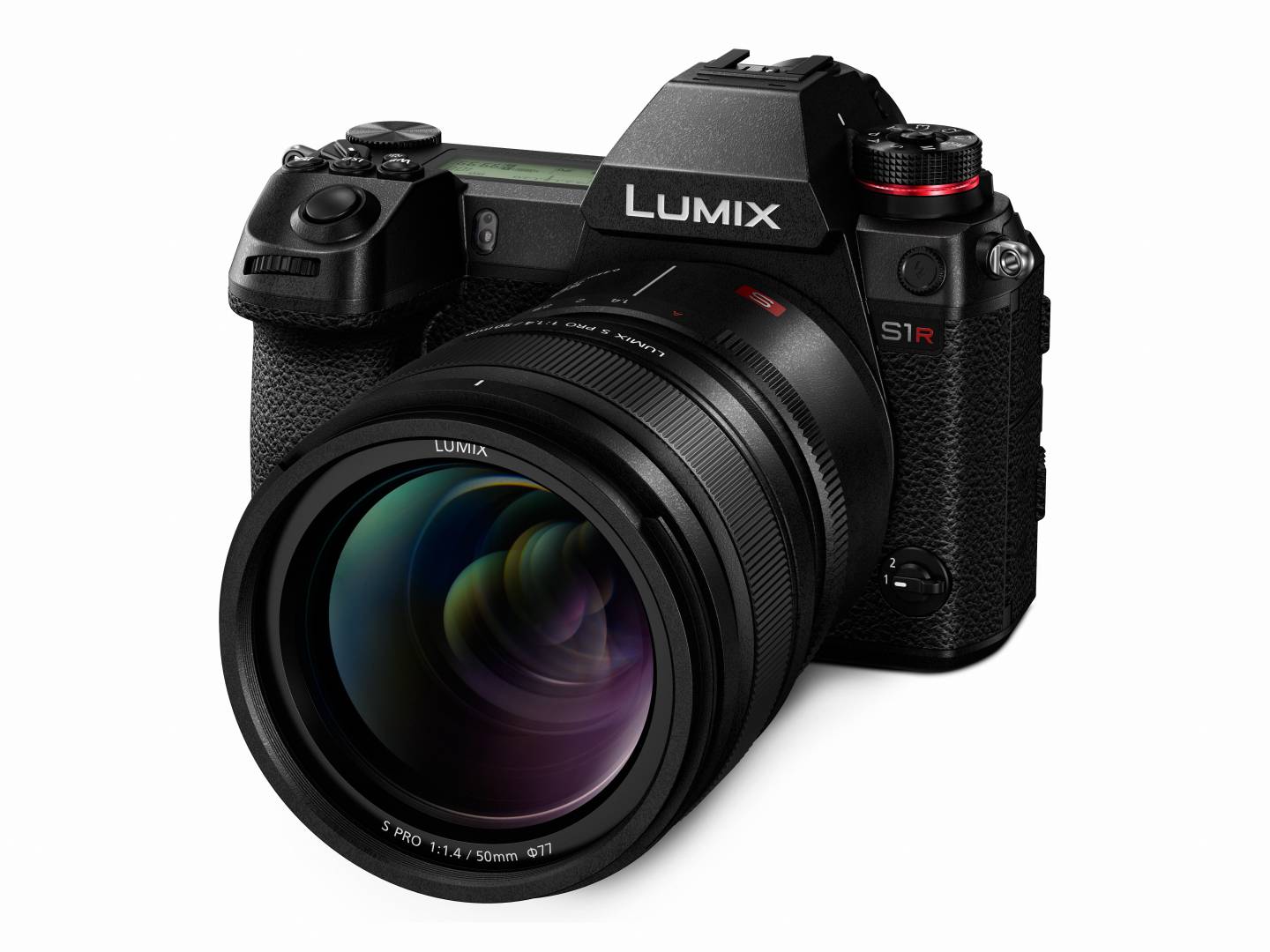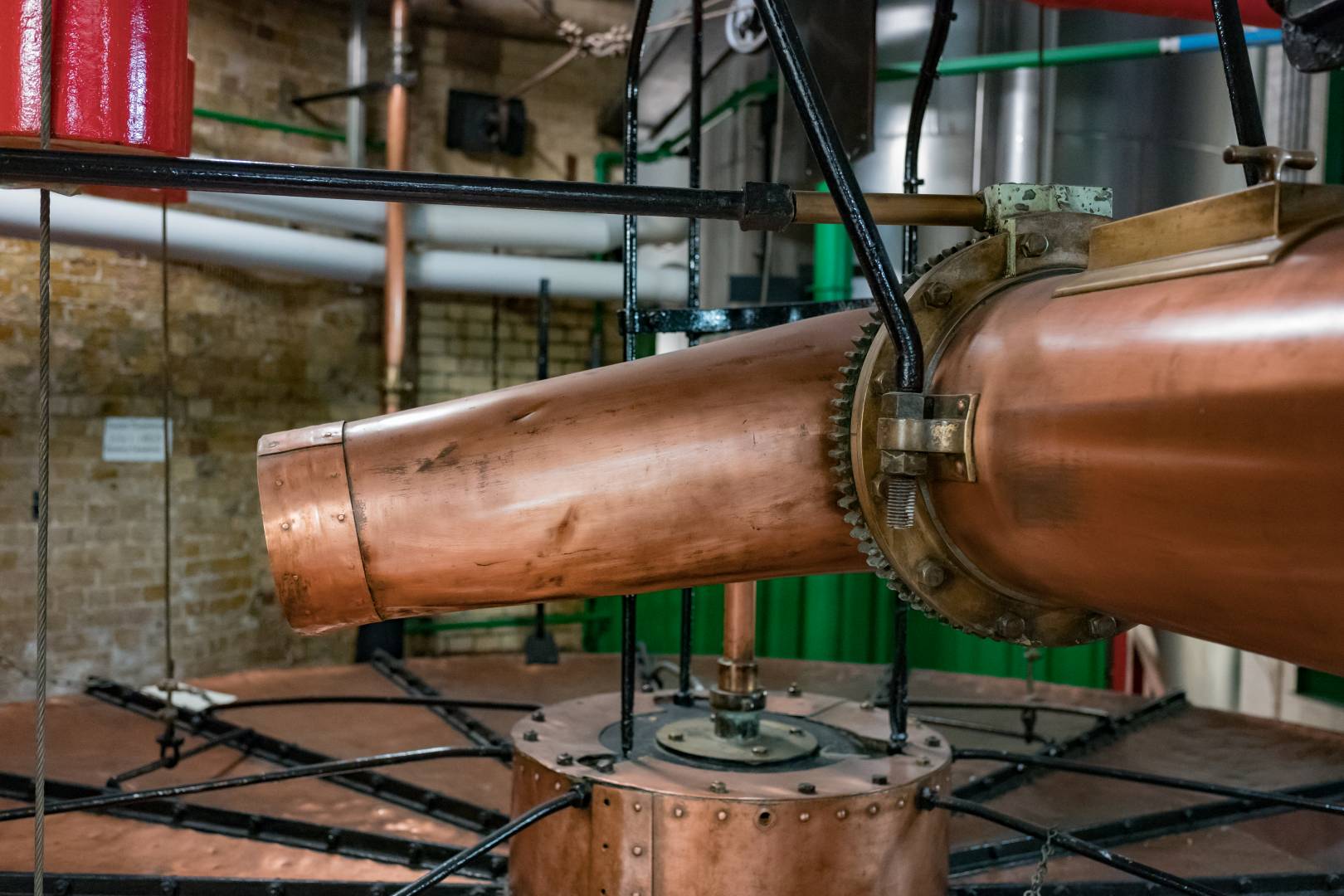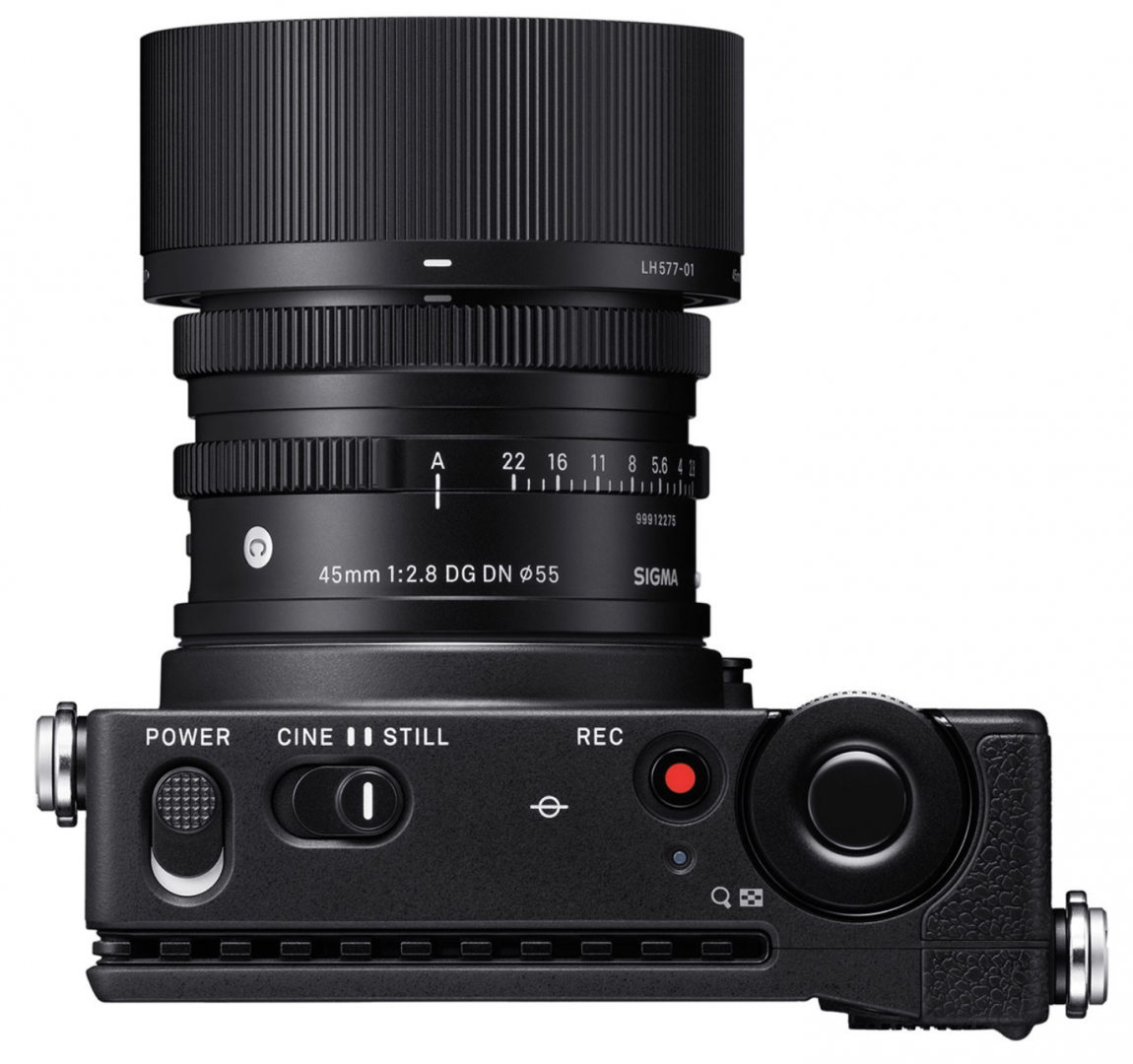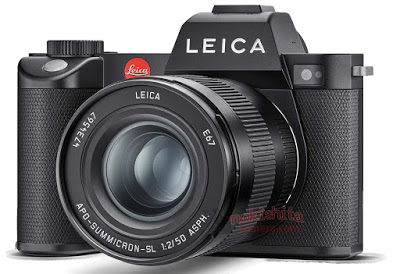With the basic specification of the new Leica SL2 and purported photographs having been leaked, we now have a fair idea of what the new camera will look like. Here I’ve polished the old crystal ball and have tried to envisage developments in the near future
Now we’ve seen pictures of the Leica SL 2 (or, at least, pimages of what is supposed to be the new camera) I am feeling a lot warmer towards it. Incidentally, as noted yesterday on Leica Rumors, Leica France has rather carelessly leaked more pictures of the SL2 on Instagram. Wetzlar’ a marketing department is unlikely to be ecstatic about this.
The Bauhaus lines of the original, with its sharp corners and a grip as ramrod straight as a Grenadier guardsman’s spine — a grip designed to fit the concepts of the designer rather than the contours of the human hand — didn’t do much for me.
But while they appear to have been softened a little, the new lines still look decidedly less finger-friendly than those of the Lumix S1.
Panasonic’s S1 and S1R models are definitely more cuddly and designed for humans than the old SL.
Spec wishlist
Expected in the last part of the year (I think it is probably too late to see it this month, so my bet would be on an early November launch), the SL2 will certainly have a 47MP sensor. It will be a tad sleeker than its predecessor and will feature the now standard Leica control layout, with the three buttons to the left of the screen, as seen on the CL and Q2.

As yet, we have no steer on the presence of in-body optical image stabilisation. We are hoping that the SL2 will lean heavily on the Panasonic S1R in this respect and I would be mightily surprised if stabilisation isn’t in the mix.
I would also be astonished if the SL2 doesn’t adopt the 5.76MP electronic viewfinder of the Panasonic S1R.
There is clearly a great deal of cooperation between the two companies — although for competition reasons they have to preserve a certain cordon sanitaire — and that’s no bad thing. Panasonic has the experience on the electronics side, especially in in-body optical stabilisation which will be a new departure for Leica. They would be mad not to feed off one another.
SL to soldier on?
But there are still some uncertainties. Steve Huff makes a call which will be echoed by many SL enthusiasts — for the retention of the current SL with its 24MP sensor as a tandem offering.
There is no doubt that some owners are reluctant to move to the larger sensors because of the speed and storage implications. There’s also the fact that the denser sensors do not perform quite as well in low light as their 24MP predecessors (at the moment, but this will change). For confirmation of this, you have to ask why Sony chose a 12MP sensor for the original light-gobbling a7s. The larger pixels were better in low-light and for dynamic range.
The Q2 has been around for nine months and I know that many Q owners have been reluctant to upgrade for this reason. They are happy with what they’ve got and found the 24MP sensor to be an all-round good egg, an acceptable compromise between image quality and practicality. That said, there is evidence that reluctance is disappearing. There are more and more used Q cameras on the market, some for as little as £2,000, and this is sure evidence of upgrading gathering pace.
I’m happy to add my voice to Steve’s for continued production of the SL. Even better, it could be a good move to retain the 24MP sensor as a cheaper offering but to give it the body and other technical enhancements we expect in the SL2. Let’s call it the SL 1.1.
Incidentally, the designation SL2 is only an assumption, a sort of working-rumour title. It could be called something else, or simply the continuity SL. But the established use of Q2 provides a good clue that it is a logical guess. I think that after the debacle of the M240 (Typ Wotsitsname) they’ve learned a useful lesson in clarity of nomenclature.
Disappointment looms
Sadly, I fear, we are all going to be disappointed.
Leica could have continued the Q (or Q-P, preferably) alongside the Q2 but decided against it. The same is almost certain to happen with the SL. One likely suspect is manufacturing capacity; it could simply have been impossible to continue with the older model of the Q. Leica presumably doesn’t have the economy of scale enjoyed by, say, Panasonic. That company now has three S1 models serving different sectors of the market, all with the same body. I think Leica will stay well out of this segmented market.
I feel certain that the SL with its 24MP sensor is now dead. No more are being made and the heavy discounting of earlier this year has cleared out stocks of new bodies. While there was a glut of second-hand SL bodies around the time of the price reductions, these now seem to have dried up and second-hand prices have risen a little. This tells us that demand is still there and I suspect the original SL will still have a charmed life on the used market for some years to come, especially now that it is comparable in price with a new Panasonic S1.
The good news is that the arrival of the SL2 will lead to a relative glut of used SLs and wil herald, at least temporarily, a bargain-hunter’s paradise.
Leica has moved on and all its future full-frame digital designs are likely to have sensors with more than 40-million pixels.
What’s brewing on the M front?
The move to denser sensors will also impact the rangefinder M family in the near future. While we are some time away from an M11 — I would guess sometime in late 2021 or early 2022 — there has been persistent chatter of an interim M10 model with a larger sensor. There could be something in this because it would provide a useful testbed for the M11 when it arrives.
Contrary to some suggestions, however, this sensor is unlikely to be the 47MP chip from the Q2 and SL2. The rangefinder has different requirements in sensor design. It is far more likely to be a sensor in the early 40s and rather than the 47.3MP sensor of the SL2.

M for Mirrorless?
Rumours are also buzzing around about the possibility of a smaller mirrorless system camera based on the M mount. But this doesn’t seem sensible from a commercial point of view. The M mount is likely to remain the preserve of the rangefinder. I imagine that if we do see such a beast it will feature the new L-mount to give it wider acceptance and allow the the use of autofocus as well as manual lenses. We could think of it as a Q with L-mount.
One of the biggest challenges in designing such a camera, however, is heat dissipation, especially if they want to shoehorn in a 40+MP sensor. A Panasonic technician involved in the design of the S1R told me last year that heat had been one of the biggest problems facing the engineers, despite the relatively huge size of the body. On the other hand, Leica (possibly aided by Panasonic) managed the trick with the Q2, so there is hope.

Smaller bodies dissipate heat more slowly, thus raising the
However, as we’ve discussed, not everyone welcomes larger sensors. Some believe that 24MP represents a sort of plateau — a standard that is good enough without the need for added complication and slower processing. While it is currently a strongly held feeling — hence Panasonic’s pandering to both ends of the spectrum — it is likely to be only a temporary phenomenon.
Competitive
We will undoubtedly soon get used to 47MP, by which time the early adopters will have moved on towards 100MP. Improved processor speeds, better heat management and enhanced low-light performance will all contrive to make the larger sensor fully competitive. And by that time we’ll be looking back nostalgically to the “more-than-adequate” 24 megapixels.
If we have learned anything from consumer computer technology over the past 40 years, it is that storage and speed (not to mention the size of software packages) expand to meet requirements. They just bring a few growing pains along the way.
The next three months will produce a number of new launches in the L-Mount world and, I suspect, just a few surprises. But I think we will have to wait until late 2021 before we get wind of the M11.



So the new SL2 has been doing the rumour rounds for some time now with claims that it would be announced in June, then 24 September and I even saw one that suggested it would be announced in October…but now silence. When in your opinion might we actually have some sort of announcement from Leica?
Best regards
John
I imagine it will appear within the next few weeks. But not before the end of October.
Hi Mike, I’m not clear why an M with an evf would make no commercial sense. I have been waiting for such a model and I’m sure many others too. I see someone has already posted here about diopters and visoflex. Why have these alternative arrangements if the technology allows to build an evf ? I think it will widen its appeal.
I hope you are right, Mahesh. Judging by the number of people who tell me they can no longer manage the rangefinder (usually because of ageing eyes) there is a demand. And most of us dislike having to use an adapter which adds a little weight and some millimetres to the lens. Perhaps there is hope!
Hi Mike, I found the SL to be the most beautiful piece of sculpture and it gathered tons of attention from people in general saying how gorgeous it looked. I sold it because the sharp edges were not pleasant for hours of carrying. I replaced it with the Hasselblad X1d and I feel it takes second place for a piece of art and it was somewhat more comfortable to hold. I believe that the Leica M cameras of almost any model except for the incredibly tacky special limited editions that sell to collectors and so thankfully never leave their box.
I have no interest in a future SL model as I love my Panasonic S1 and S1R in usage and the fit is wonderful and perfect for me.
I agree that for most things I think that sensors in the 18MP to 24 MP are in the sweet spot for most formats below medium format. They have a great balance of resolution and low light performance. Also, anything above that really starts taking a toll on computer resources and speed of processing. I had to upgrade my quality graphics card when I upgraded to 50MP as my computer kept freezing or software would freeze if I had multiple applications open – especially Topaz. I could not even run Topaz AI software at all unless I downsized the files.
Also, people are going to discover that a lot of the glass they own will not perform well with 50MP sensors and images will be softer than 24MP sensors. People need to be aware when they upgrade to 50 MP that they may be purchasing a finicky race car to drive their kids to soccer and end up with extravagant operating costs.
The other issue that arises with 50MP is that your shooting technique must be much more careful with 50 MP or images will be noticeable soft.
I purchased a Leica M-E with the ancient 18MP sensor brand new from a camera dealer for a fire sale price. It was an open box camera with the original sensor. After much negotiation, they managed to get Leica to give me a 5 year warranty instead of 2 years. The store now will not open a Leica box for someone that has not purchased as they have had to heavily discount open box Leica items by a minimum of 10 percent to sell them. I love nutty Leica buyers. They love the patina on their equipment until they sell or buy as most of them want to buy pristine.
I am a happy camper; I absolutely love the rendering of this sensor. And 18 MP is quite adequate. I will limit it to ISO 800 and be delighted as I used to shoot Kodachrome 25 and 64 in my film days. I think most people are getting convinced by marketing that they need more than they really need – I know because I got sucked in for years.
I have named my Leica M-E (typ 220) Bijou which is French for jewel. I will never sell her. She is steam powered but I am not a spray and pray shooter. I am smitten by her files. I am waiting for a half case for her so that I can remove the bottom plate plastic.
I admit it- I am extremely fond of my SL’s grip. I find it does not force me to place my hand where the designer wants it, but rather where it’s the most comfortable for me. I can slide my hand up or down to my hearts content. I tried the S1R, and I found the grip to be annoying. The ‘overhang’ below the release puts a lot of pressure on my middle finger joint. I walked around with it for a few hours with a 24-90 and actually had the start of a blister on my aforementioned joint. OK, so maybe more trips to the gym. Other than that, I confess I did like the S1R, especially the IBIS. Bottom line: I for one (maybe the only one!) will be thrilled if the ‘SL2’ keeps a similar grip!
On another note, I’m also really fond of my M10-P. I’m quite pleased at 24 mp, and not sure what to think about 40+. One thing I really DO want is a diopter adjustment! Maybe the physics of it makes that impossible with a RF system- don’t know. I use the screw on diopters, but they are a real pain. I use them when I can’t see the frame lines- glasses and all that. Glasses on, diopter ring off. Diopter ring on, glasses off. Gets old fast (like me). Yes, I have the Visoflex (did I say that right?), but I’m spoiled by the SL EVF, so that leaves me wanting. Plus, the added power consumption. I find I tend to use it only on my 90 mm. Sigh.
Very insightful piece, Mike.
I know your article is mainly about the SL line, but when you come to the M have to say that I think the 24mp sensor is adequate. Do we really want 40+mp files from a M camera? How will the older lenses that are so popular work with 40+mp sensor? Although I guess it is open to interpretation and dosn’t preclude an increase in sensor size, I was interested to read the qoute from Stefan Daniel in this months LFI saying the M10 is perceived (presumably by Leica) as a fully developed camera , and is a platform that will endure for many years to come. I know ‘platform’ allows for a lot of tweaks – so I guess it is a case of wait and see!
Can’t disagree with you on 24MP, Keith. I’m very happy with the sensor in my M10-D and I feel that it is a camera that will be useful for the next ten years. But, whether we like it or not, the M is going to get a sensor of 40+MP. It’s just a matter of time and, I think, it could come sooner rather than later in a new high-res version of the M10. Until the M11 comes along, though, there will be a straight choice. After that, though, I think 24MP will be seen as old hat and will be discontinued. Fortunately, if we want to, we can stay with the M10 and continue to enjoy a camera that really does look like the pinnacle of rangefinder design. But don’t quote me on that in five years’ time!
hi Mike
i also hear from a leica store Porto that most older lenses could resolve really high and lenses like noctilux can resolve upto 50MP (not sure if anyone has verified it). but if it is true then a higher resolving sensor shouldn’t be a problem for older lenses.
I have also been told than, Kannan. And all the later M designs should have no problems.